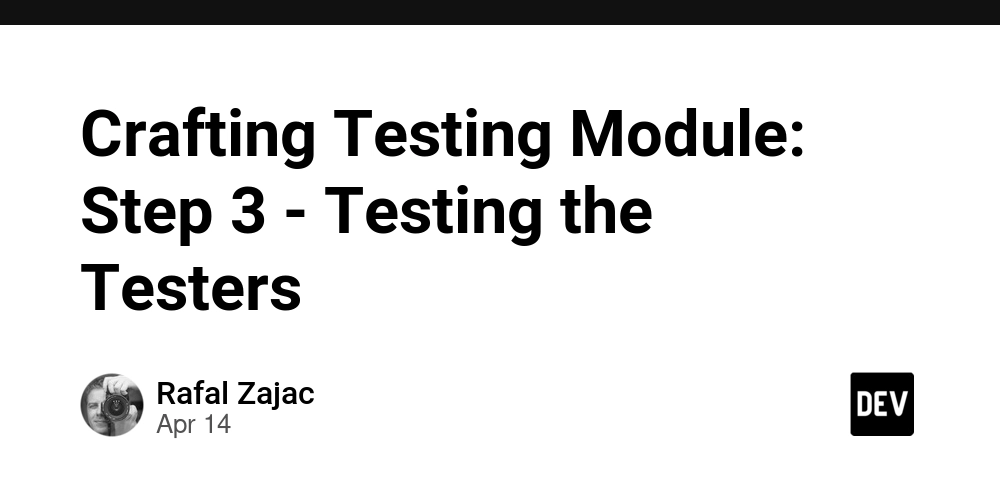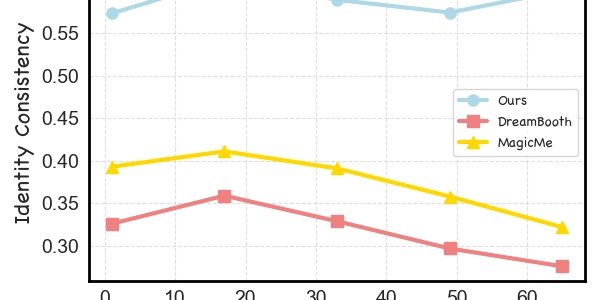Crafting Testing Module: Step 3 - Testing the Testers
In my previous post, I introduced the core and affirm packages, laying the groundwork for a dependency-free Go testing module focused on readable, intuitive tests. Now, in this third installment, I’m diving into testing the affirm package - specifically, how to verify its assertion helpers. I’ll share my thought process, the challenges I faced, and how I solved them. Let’s get started! Follow Testing Module development on GitHub Why Test Testing Tools? You might ask: why go through the trouble of testing tools meant for testing? It’s a valid question, and the answer boils down to trust. If an assertion like does not work properly or misreports a crash, every test relying on it risks silent failures or false positives. That undermines reliability. By thoroughly testing, I ensure packages I create are dependable - it's like calibrating a ruler, you just created, before measuring with it. Plus, these tests serve as living examples, showing how the pieces fit together as the module grows. The Challenge of Testing Affirmations Testing the core package was relatively straightforward, as its utilities (IsNil, WillPanic, Same) don’t interact directly with *testing.T. The affirm package, on the other hand, poses a challenge. Its helpers - such as Equal, Nil, and Panic - rely on *testing.T to log errors and failures, among other tasks, making them harder to test without affecting the actual test runner. Consider the Equal helper: func Equal[T comparable](t *testing.T, want, have T) bool { t.Helper() if want != have { const format = "expected %T to be equal:\n want: %#v\n have: %#v" t.Errorf(format, want, want, have) return false } return true } Testing the success case is simple enough. We can use the test’s own *testing.T instance: func Test_Equal_success(t *testing.T) { // --- When --- have := Equal(t, 42, 42) // --- Then --- if !have { t.Error("expected true") } } This works because when want equals have, Equal doesn’t call t.Errorf, and the test passes quietly. But testing the failure case is problematic: func Test_Equal_failure(t *testing.T) { // --- When --- have := Equal(t, 42, 44) // --- Then --- if have { t.Error("expected false") } } Here’s the catch: when want doesn't equal have, Equal calls t.Errorf, which marks the test as failed in the real test runner. Even though Equal behaved correctly (logging the error and returning false), the test itself fails, masking the fact that we’re verifying the right behavior. This is a classic testing conundrum: how do we test a function that triggers test failures without failing the test? A Solution At this stage, my Go testing module doesn’t yet have a full-fledged mocking library (that’s coming later - stay tuned!). To test affirm helpers, I needed a way to intercept *testing.T calls without affecting the actual test runner. That’s where the core package’s T interface and Spy struct come in. I introduced the T interface to capture a subset of testing.TB methods used by affirm helpers: // errors or failures. type T interface { Error(args ...any) Errorf(format string, args ...any) Failed() bool Fatal(args ...any) Fatalf(format string, args ...any) Helper() } The Spy struct implements this interface, acting as a mock *testing.T: type Spy struct { HelperCalled bool // Tracks if Helper was called. ReportedError bool // Tracks if Error or Errorf was called. TriggeredFailure bool // Tracks if Fatal or Fatalf was called. Messages *bytes.Buffer // Log messages if set. } With Spy, I can track whether an assertion helper called Error, Errorf, or other methods, and inspect the logged messages when needed — all without failing the actual test. Adapting Affirm Helpers To use Spy, I updated affirm helpers to accept core.T instead of *testing.T. For example, here’s the revised Nil helper: func Nil(t core.T, have any) bool { t.Helper() if core.IsNil(have) { return true } t.Errorf(expected, nil, have) return false } This change is subtle but powerful: by using the core.T interface, helpers become testable with Spy while still working with *testing.T in real tests (since *testing.T implements core.T). Writing Tests with Spy Now, testing both success and failure cases becomes straightforward. Here’s how I test the Nil helper: func Test_Nil(t *testing.T) { t.Run("success", func(t *testing.T) { // --- Given --- spy := core.NewSpy() // --- When --- have := Nil(spy, nil) // --- Then --- if !have || spy.Failed() { t.Error("expected passed test") } }) t.Run("error", func(t *testing.T) { // --- Given --- spy := core.NewSpy() err := errors.New("m0") // ---

In my previous post, I introduced the core and affirm packages, laying the groundwork for a dependency-free Go testing module focused on readable, intuitive tests. Now, in this third installment, I’m diving into testing the affirm package - specifically, how to verify its assertion helpers. I’ll share my thought process, the challenges I faced, and how I solved them. Let’s get started!
Follow Testing Module development on GitHub
Why Test Testing Tools?
You might ask: why go through the trouble of testing tools meant for testing? It’s a valid question, and the answer boils down to trust. If an assertion like does not work properly or misreports a crash, every test relying on it risks silent failures or false positives. That undermines reliability. By thoroughly testing, I ensure packages I create are dependable - it's like calibrating a ruler, you just created, before measuring with it. Plus, these tests serve as living examples, showing how the pieces fit together as the module grows.
The Challenge of Testing Affirmations
Testing the core package was relatively straightforward, as its utilities (IsNil, WillPanic, Same) don’t interact directly with *testing.T. The affirm package, on the other hand, poses a challenge. Its helpers - such as Equal, Nil, and Panic - rely on *testing.T to log errors and failures, among other tasks, making them harder to test without affecting the actual test runner.
Consider the Equal helper:
func Equal[T comparable](t *testing.T, want, have T) bool {
t.Helper()
if want != have {
const format = "expected %T to be equal:\n want: %#v\n have: %#v"
t.Errorf(format, want, want, have)
return false
}
return true
}
Testing the success case is simple enough. We can use the test’s own *testing.T instance:
func Test_Equal_success(t *testing.T) {
// --- When ---
have := Equal(t, 42, 42)
// --- Then ---
if !have {
t.Error("expected true")
}
}
This works because when want equals have, Equal doesn’t call t.Errorf, and the test passes quietly. But testing the failure case is problematic:
func Test_Equal_failure(t *testing.T) {
// --- When ---
have := Equal(t, 42, 44)
// --- Then ---
if have {
t.Error("expected false")
}
}
Here’s the catch: when want doesn't equal have, Equal calls t.Errorf, which marks the test as failed in the real test runner. Even though Equal behaved correctly (logging the error and returning false), the test itself fails, masking the fact that we’re verifying the right behavior. This is a classic testing conundrum: how do we test a function that triggers test failures without failing the test?
A Solution
At this stage, my Go testing module doesn’t yet have a full-fledged mocking library (that’s coming later - stay tuned!). To test affirm helpers, I needed a way to intercept *testing.T calls without affecting the actual test runner. That’s where the core package’s T interface and Spy struct come in. I introduced the T interface to capture a subset of testing.TB methods used by affirm helpers:
// errors or failures.
type T interface {
Error(args ...any)
Errorf(format string, args ...any)
Failed() bool
Fatal(args ...any)
Fatalf(format string, args ...any)
Helper()
}
The Spy struct implements this interface, acting as a mock *testing.T:
type Spy struct {
HelperCalled bool // Tracks if Helper was called.
ReportedError bool // Tracks if Error or Errorf was called.
TriggeredFailure bool // Tracks if Fatal or Fatalf was called.
Messages *bytes.Buffer // Log messages if set.
}
With Spy, I can track whether an assertion helper called Error, Errorf, or other methods, and inspect the logged messages when needed — all without failing the actual test.
Adapting Affirm Helpers
To use Spy, I updated affirm helpers to accept core.T instead of *testing.T. For example, here’s the revised Nil helper:
func Nil(t core.T, have any) bool {
t.Helper()
if core.IsNil(have) {
return true
}
t.Errorf(expected, nil, have)
return false
}
This change is subtle but powerful: by using the core.T interface, helpers become testable with Spy while still working with *testing.T in real tests (since *testing.T implements core.T).
Writing Tests with Spy
Now, testing both success and failure cases becomes straightforward. Here’s how I test the Nil helper:
func Test_Nil(t *testing.T) {
t.Run("success", func(t *testing.T) {
// --- Given ---
spy := core.NewSpy()
// --- When ---
have := Nil(spy, nil)
// --- Then ---
if !have || spy.Failed() {
t.Error("expected passed test")
}
})
t.Run("error", func(t *testing.T) {
// --- Given ---
spy := core.NewSpy()
err := errors.New("m0")
// --- When ---
have := Nil(spy, err)
// --- Then ---
if have || !spy.Failed() {
t.Error("expected test error")
}
if !spy.ReportedError {
t.Error("expected test error")
}
})
}
The success case verifies that Nil returns true for a nil input and doesn’t mark the test as failed. The failure case confirms Nil returns false for a non-nil input, and uses Errorf to mark the test as failed. The Spy lets me inspect the helper’s behavior - return values, error states, and log output - without interfering with the real test runner.
Another benefit is that helpers can call t.Fatal or t.Fatalf without causing the real test to panic or exit the goroutine, making Spy a versatile tool for testing all kinds of assertions.
Trade-Offs and Reflections
Switching affirm helpers to use core.T instead of *testing.T is a pragmatic choice, but it’s not without trade-offs. On one hand, it makes testing possible without a full mocking framework. On the other, it slightly increases the package’s complexity by introducing an interface. I’m okay with this for now - it’s a small price for testability, and T is narrowly scoped to internal packages only.
Another consideration is Spy’s design. It’s minimal, capturing only the essentials (errors, failures, messages), but it’s flexible enough to grow if I add more assertion helpers later. For example, if I introduce helpers that call Fatal or FailNow, Spy’s TriggeredFailure field will already handle them.
Closing Thoughts
Testing the affirm package pushed me to think creatively about mocking *testing.T, and I’m thrilled with how Spy and T turned out. They’re not just tools for testing affirm — they’re building blocks for a module that’s as reliable as it is intuitive. This step reinforced my belief that trustworthy tests start with trustworthy tools.
As always, I’d love for you to check out the progress on the GitHub repository. The code and early docs are there - feel free to explore, test it out, or share feedback via an issue. You can also follow updates on X. Your thoughts help shape this journey, so don’t hold back!











































































































































































![[The AI Show Episode 144]: ChatGPT’s New Memory, Shopify CEO’s Leaked “AI First” Memo, Google Cloud Next Releases, o3 and o4-mini Coming Soon & Llama 4’s Rocky Launch](https://www.marketingaiinstitute.com/hubfs/ep%20144%20cover.png)








































































































































































































































.png?#)








-Baldur’s-Gate-3-The-Final-Patch---An-Animated-Short-00-03-43.png?width=1920&height=1920&fit=bounds&quality=70&format=jpg&auto=webp#)























_Aleksey_Funtap_Alamy.jpg?width=1280&auto=webp&quality=80&disable=upscale#)












































































































![Apple's Foldable iPhone May Cost Between $2100 and $2300 [Rumor]](https://www.iclarified.com/images/news/97028/97028/97028-640.jpg)
![Apple Releases Public Betas of iOS 18.5, iPadOS 18.5, macOS Sequoia 15.5 [Download]](https://www.iclarified.com/images/news/97024/97024/97024-640.jpg)
![Apple to Launch In-Store Recycling Promotion Tomorrow, Up to $20 Off Accessories [Gurman]](https://www.iclarified.com/images/news/97023/97023/97023-640.jpg)





































































































































